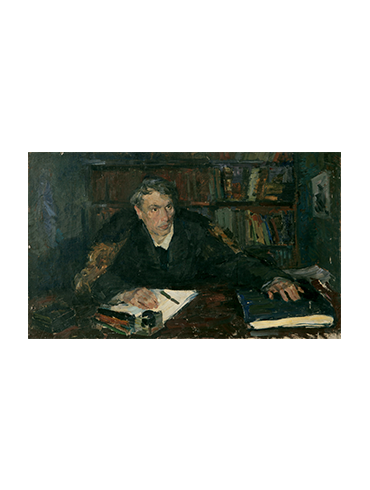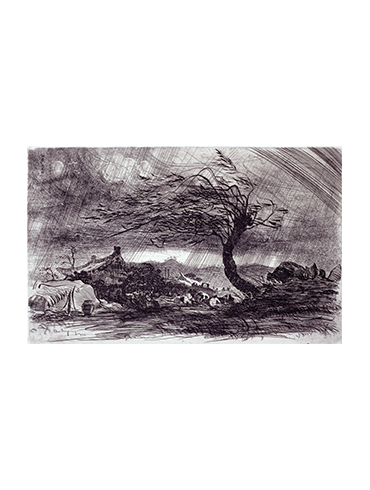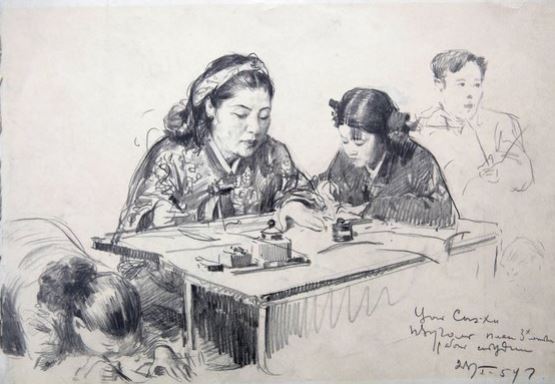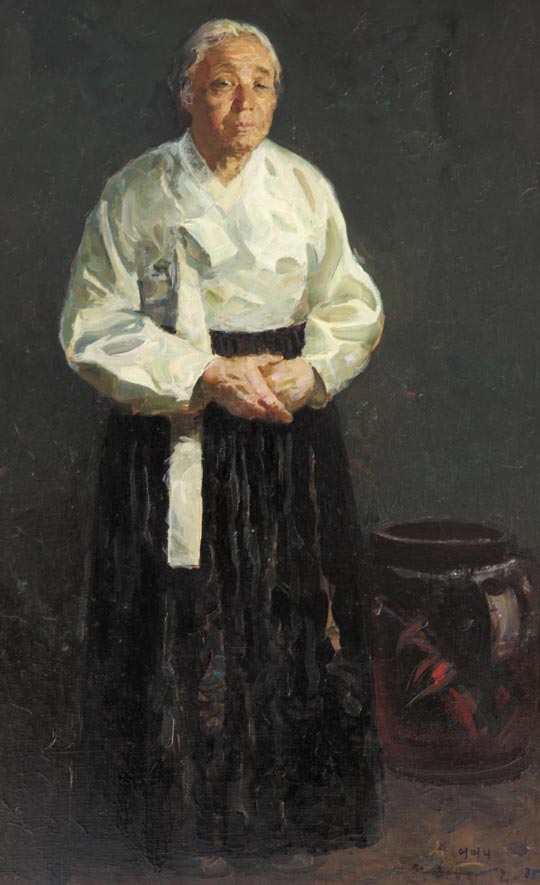변월룡 (邊月龍, 1916~1990)
1916년 9월
29일 연해주(沿海州) 쉬코토프스키
구역의 유랑촌에서 1남 2녀 중 막내로 태어남. 농부였던 아버지 변창호는 아들이 태어나기 전에 가출, 이후 생사
여부는 전혀 알려지지 않음.
1922년 (6세) 할아버지가 유랑촌 인근에 살고 있는 나이 많은 중국인 서예가에게
손자 교육을 부탁함. 변월룡은 그때 배운 서예가 교육의 전부였는데, 할아버지가
돌아가시자 이마저 그만두게 됨. 하지만 그때 익힌 한자 서예는 훗날 화가로 성장하는 데 밑거름이 됨.
1926년 (10세) 블라디보스토크의 신한촌에 있는 ‘4년제
한인 학교’에 입학. 보통 만 7살에 입학하는 것을 감안하면 3년 정도 늦은 입학이었음.
1928년 (12세) 당시 전면적 학제 개편(10년제로
전환)에 따라 ‘블라디보스토크 8호 모범 10년제 학교’로
전학. 그 학교는 고려인들이 세워 고려인 자녀들만 다녔던 학교로서 당시 한인 학교 중 가장 명문이었음. 변월룡은 이 학교에 다니면서부터 그림에 천부적 재능을 드러냄.
1932년 (16세) 7학년 때부터는 전문적인 미술교육을 받지 않았음에도 아동 전문 출판사에서
전문적 삽화를 그림. 연해주 일대의 한인 학교의 전 학년 전 과목 교과서 그림을 혼자 도맡아 그림. 아울러 극장들의 포스터와 간판을 그리는 일에도 뛰어들어 가정을 도움.
1936년 (20세) 일과 공부를 겸하면서도 우수한 성적으로 중·고등학교를
마침. 학교를 졸업한 후에도 그림 그리는 아르바이트를 계속함.
1937년 (21세) 우랄산맥 부근에 위치하고 있는 스베르들로프스크(현 예카테린부르크) 미술학교에 입학.
스탈린의 강제 이주 정책이 갑작스럽게 시행되어 연해주에 살던 한인들이 중앙아시아로 강제 이주를 당함.
변월룡은 연해주를 떠나있어서 강제 이주를 당하지는 않았지만, 가족들이 타슈켄트로 강제 이주
당하면서 가족과의 소식이 끊겨 한동안 이산가족으로 지냄.
1940년 (24세) 스베르들로프스크 미술학교를 우수한 성적으로 졸업하고 레닌그라드(현 상트페테르부르크)에 있는 ’러시아 예술아카데미(현 레핀·회화·조각·건축 예술대학)’ 회화부에 합격. 그곳에서 네 살 아래인 평생의 동반자인 부인 제르비조바를
만남. 변월룡은 회화부 학생이면서도 스스로 폭넓은 공부를 하기 위해 틈만 나면 판화 화실에 들러 동판화와
석판화를 전문적으로 익힘.
1941년 (25세) 1학년을 마치던 6월 초에
어머니와 누이가 살고 있는 타슈켄트로 떠남. 그때 뜻밖에도 독·소전쟁과 맞닥뜨리게 됨. 새 학년이 시작될 무렵 학교로 돌아가려 하지만 ‘레닌그라드 봉쇄’로 돌아갈 수 없게 되자 타슈켄트의 한 출판사에서 삽화 그리는 일을 함.
1942년 (26세) 2월
19일, 예술아카데미는 포위된 도시 레닌그라드를 탈출. 우즈베키스탄의 사마르칸트로 피난함. 3월 말경 무사히 사마르칸트에
도착. 학기 시작할 즈음에 변월룡도 사마르칸트에 와서 합류. 거기서도
변월룡은 학업과 타슈켄트 출판사에서 정치 포스터를 제작하는 일을 병행함.
1944년 (28세) 예술아카데미가
자고르스크로 피난처를 옮김. 거기에서 변월룡은 동급생 제르비조바와 결혼. 여름 방학 때 중병이 걸린 어머니를 뵈러 혼자 타슈켄트로 감. 9월
말경에 예술아카데미는 자고르스크에서 레닌그라드로 돌아가고, 변월룡은 타슈켄트로 피난 왔던 레닌그라드
음악원 학생들에 끼여 레닌그라드로 돌아감. 전쟁 후 러시아 예술아카데미는 ‘레핀 회화·조각·건축 예술대학’으로 개명.
1945년 (29세) 5월 9일 제2차 세계대전 종료. 첫아들
알렉산드르가 태어나고, 중병을 앓던 어머니가 세상을 떠남
1947년 (31세) 레핀
회화·조각·건축 예술대학(이후 레핀미술대학)의 A. A. 오스묘르킨 교수의 회화반에서 졸업 작품 〈조선의 어부들〉이란 테마의 그림으로 수석을 차지, 금메달을 목에 검. 졸업과 동시에 교수들의 추천으로 레핀미술대학
대학원에 진학하여 B. V. 이오간손 지도 교수 밑에서 박사 학업에 정진하게 됨. 같은 해 소련미술가연맹 레닌그라드 지부의 회원으로 발탁됨. 이후
1959년을 제외하곤 同 전시회에 빠짐없이 출품함.
1950년 (34세) 〈휴양지의
레닌과 스탈린, 중대한 우호관계〉라는 작품을 모스크바의 전 소련전시회에 출품함. 전시회에 정기적으로 참석하기 시작.
1951년 (35세) 〈휴양지의
레닌과 스탈린, 중대한 우호관계〉를 졸업작품으로 대학원을 성공적으로 마침. 건축 예술부 데생과 조교수의 직책을 부여받아 본격적으로 교수 활동 시작. 소련
미술학 박사 학위증을 수여받음.
1952년 (36세) 둘째
아들 세르게이 태어남.
1953년 (37세) 부교수
승진과 함께 1953년 6월부터 소련 문화성(文化省)의 지시에 따라 북한의 교육성(敎育省) 고문관으로 파견됨. 평양미술대학
학장 및 회화·데생·무대미술과 과장의 고문으로 일하면서, 평양미술대학의 교육 체계를 바로잡는 것은 물론
교수들을 지도·육성하는 데에도 힘씀.
1954년 (38세) 1954년 9월, 소련으로 돌아와 레핀미술대학에
복직. ‘레닌그라드 예술가’의 전시회와 ‘전 소련예술가동맹’에서 조직한 전시회에 북한에서 그린 작품들만으로
출품함. 이후 다른 전시회에도 북한에서 그린 데생, 인물화, 풍경화들로 전시장을 채우는데, 고국과 관련된 테마는 한동안 변월룡
작품의 근간으로 작용함. 소련 예술아카데미 후원 하에 대학의 유명 교수들로 구성된 『데생 회화 방법론』
서적 출판에 참여하며 자신의 글도 게재함.
1955년 (39세) 그동안의
작품 활동과 연구 성과로 레닌그라드 미술가협회로부터 화실을 배정받음. 북한 파견 임무를 성공적으로 치러
낸 점을 인정받아 정부 당국으로부터 아파트 입주권을 받았으나, 레닌그라드 당 수뇌부가 가로챔으로써 소수
민족의 설움을 톡톡히 맛봄. 8월, 레닌그라드에서 ‘조선 해방 10주년 경축 공연’ 단장으로
온 죽마고우 정상진을 만나 고국으로 복귀 희망을 전했으나, 정상진이 북한으로 돌아가자마자 숙청이 됨으로써
복귀 희망이 무산됨.
1956년 (40세) 소련
대사 이상조를 만나 고국으로의 복귀 희망을 피력함. 그러나 그마저 숙청되는 바람에 또다시 희망이 사그라지면서
심한 좌절감을 맛봄. 하지만 북한의 지인들과의 편지 왕래는 계속되었음.
1957년 (41세) ‘10월
혁명 40주년 기념 레닌그라드 미술가 작품전’에 약 300호 크기의 유화 작품 〈평양의 해방 기념일〉 출품.
1958년 (42세) 딸
올가 태어남.
1959년 (43세) 북한의
‘해외동포 고국방문단’에 신청서를 냈지만, 변월룡만 유일하게 고국방문단 명단에서 제외됨. 명단에서 제외된 사유가
자신의 숙청 때문이란 사실을 알게 됨. 그 충격에 따른 상심이 컸던지 이 해에는 어느 전시회에도 불참하는
등 일체의 활동을 접음.
1961년 (45세) 자력으로
화실 근처에 아파트를 마련함. 이탈리아, 그리스, 터키, 알바니아, 유고슬라비아, 네덜란드를 두루 여행함. 자신의 숙청 사실을 인정할 수 없어 그
부당성을 알리고 억울함을 해소하는 차원에서 이해부터 1964년까지 연해주 지역을 방학 때마다 매년 다녀옴.
1963년 (47세) 스웨덴을
방문하여 스톡홀름 예술아카데미의 교육방법에 관심을 가짐. 유일한 유화 〈자화상〉을 그림.
1964년 (48세) 연해주를
다녀온 이 해부터 고국에 대한 미련과 상념을 접음. 이후부터는 더 이상 작품에서 고국에 관한 그림을
찾아볼 수 없게 됨. 고향 〈쉬코토보〉를 동판화로 제작.
1966년 (50세) 이
해부터는 자신의 정체성을 찾아 연해주 지역을 1980년대 초반까지 방학 때마다 다녀옴.
1970년 (54세) 네덜란드와 벨기에 방문.
1972년 (56세) 레핀미술대학 학생들을 이끌고 체코슬로바키아의 프라하로 현장실습 스케치를
다녀옴.
1973년 (57세) 유화 〈우리 시대의 사람들〉을
완성하여 ‘1973년 레닌그라드 미술가 지역 전람회’에 출품함. 그림의 크기가 무려 360x531cm로서 1970년부터 1973년까지 3년 동안 그린 그림임.
현재 이 그림의 소재를 알지 못함.
1974년 (58세) 다시 타슈켄트 다녀옴. 중앙아시아
여행에서 얻은 인상을 바탕으로 많은 동판화 작품을 시리즈로 제작함. 그해 가을 헝가리를 여행함.
1977년 (61세) 마침내 레핀미술대학 정교수로 승진함.
부교수에서 정교수로 승진하는 데 무려 24년이 걸린 셈이지만, 한편으로 이 승진은 이민족 화가로서의 냉대와 설움을 극복한 것이기에 더욱 의미가 있음.
1981년 (65세) 프랑스 여행.
1983년 (67세) 프랑스와 포르투갈 여행.
1985년 (69세) 건강 문제로 35년을 몸담은
레핀미술대학을 퇴직하고 연금생활자가 됨. 교직에서 물러난 후에도 작품 활동을 지속하며 삶의 마지막까지
그림에 열정을 불사름.
1990년 (74세) 뇌졸중으로 1990년 5월 25일 작고. 미국
플로리다의 히벨 미술관(Hibel Museum of Art)에서 기획한 《골든브리지
Golden Bridge》展에 작품
출품. 이 전시회는 변월룡이 작고한 후에 열렸지만 처음으로 소련을 벗어나 서방 세계에서 개최된 전시회로
기록됨. 그러나 유족에 따르면 출품작 5점 중 4점만 반환되고 1점 〈자스민이 있는 정물〉(1969, 캔버스에 유채, 58x78cm)은 돌려받지 못했다고 함.































